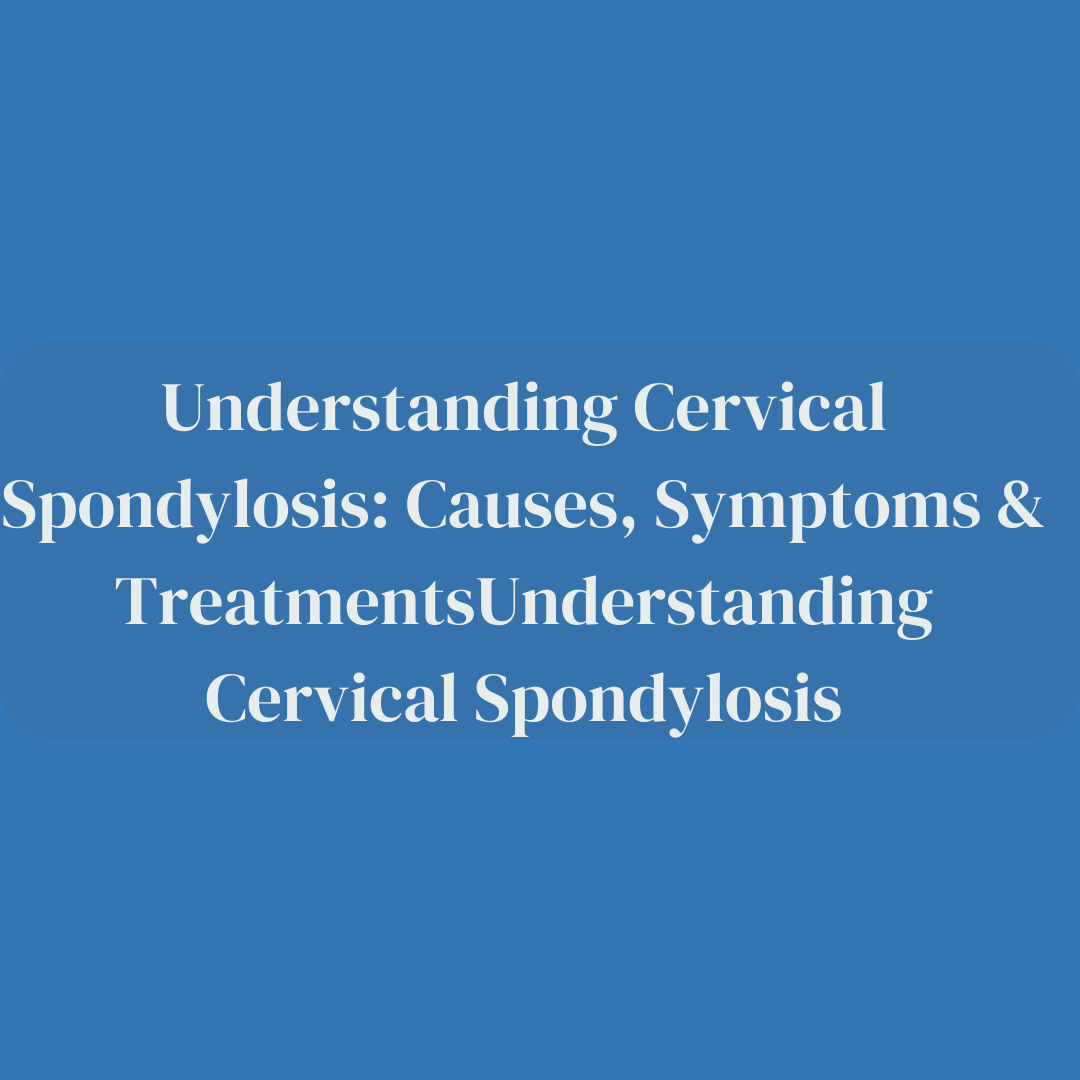Cervical Spondylosis, often referred to as neck arthritis or cervical osteoarthritis, is a common age-related condition affecting the cervical spine. This article aims to provide a comprehensive understanding of Cervical Spondylosis, including its causes, symptoms, and available treatments.
What is Cervical Spondylosis?
Cervical Spondylosis is a degenerative condition that primarily affects the vertebrae and disks in the neck (cervical spine). As we age, the disks between the vertebrae tend to shrink and lose fluid, leading to various issues in the cervical spine.
Understanding the Anatomy
To grasp the complexities of Cervical Spondylosis, it’s essential to have a basic understanding of the cervical spine’s anatomy. The cervical spine consists of seven vertebrae (C1 to C7) and is responsible for supporting the head’s weight, allowing for neck movement, and protecting the spinal cord. Between these vertebrae are intervertebral disks that act as cushions, providing flexibility and preventing bone-on-bone contact.
Causes of Cervical Spondylosis
Age as a Primary Factor
One of the primary factors contributing to Cervical Spondylosis is aging. As we grow older, the spinal disks gradually lose water content and become less flexible. This natural aging process, known as degeneration, is a significant contributor to the development of this condition.
Neck Injuries and Trauma
Aside from aging, neck injuries and trauma can also lead to the development of Cervical Spondylosis. Accidents, such as car crashes or falls, can damage the spinal structures and accelerate degeneration.
Genetic Predisposition
While aging and injuries are common causes, genetic predisposition can also play a role in some cases. If you have a family history of Cervical Spondylosis, you may be more susceptible to developing the condition.
Repetitive Neck Strain
Repetitive neck strain, often caused by poor posture or occupations that require extended periods of neck strain, can increase the risk of Cervical Spondylosis. Maintaining good posture and ergonomic work environments can help prevent strain-related issues.
Symptoms
Recognizing the symptoms of Cervical Spondylosis is crucial for early diagnosis and effective treatment. The condition’s symptoms can vary from person to person and may include:
- Neck Pain: The most common symptom is neck pain, which can range from mild to severe and may be chronic.
- Stiffness: Individuals with Cervical Spondylosis often experience neck stiffness, making it challenging to turn the head.
- Headaches: Cervical Spondylosis can cause headaches, typically starting at the base of the skull and radiating towards the forehead.
- Numbness and Weakness: Some individuals may experience numbness or weakness in the arms, hands, or fingers. This occurs when the spinal nerves become compressed or irritated.
- Loss of Balance: In severe cases, Cervical Spondylosis can affect balance and coordination.
It’s essential to consult a healthcare professional if you experience any of these symptoms, as early intervention can prevent the condition from worsening.
Diagnosis
Diagnosing Cervical Spondylosis involves a thorough evaluation by a healthcare provider. The diagnostic process may include:
- Medical History: Your healthcare provider will inquire about your symptoms, medical history, and any previous neck injuries.
- Physical Examination: A physical examination will assess your neck’s range of motion, reflexes, and muscle strength.
- Imaging Tests: To confirm the diagnosis and evaluate the extent of degeneration, your doctor may order imaging tests such as X-rays, CT scans, or MRI scans.
- Electromyography (EMG): In some cases, EMG may be used to assess nerve function and identify nerve compression.
Treatment Options
The treatment of Cervical Spondylosis aims to alleviate symptoms, improve neck function, and prevent further progression. Treatment options include:
Lifestyle Changes
- Maintaining Good Posture: Proper posture can significantly reduce neck strain and discomfort. Ensure that your workstation is ergonomically designed to promote good posture.
- Regular Exercise: Engaging in neck-strengthening exercises can improve flexibility and reduce pain.
- Weight Management: Maintaining a healthy weight can reduce stress on the cervical spine.
- Neck Support: Using neck pillows or supports while sleeping can help reduce neck pain.
Physical Therapy
Physical therapy plays a significant role in the management of Cervical Spondylosis. A trained physical therapist can create a customized exercise plan to improve neck strength and flexibility. These exercises may include stretches, neck rotations, and gentle resistance training.
Medications
- Nonsteroidal Anti-Inflammatory Drugs (NSAIDs): NSAIDs like ibuprofen can help manage pain and reduce inflammation.
- Muscle Relaxants: These medications can provide relief from muscle spasms and tension in the neck.
Surgical Procedures
Surgery is considered in cases where conservative treatments are ineffective, and severe symptoms persist. Common surgical procedures for Cervical Spondylosis include:
- Cervical Discectomy: This surgery involves removing a damaged or herniated disk to relieve pressure on the spinal cord or nerves.
- Cervical Fusion: In some cases, two or more vertebrae may be fused together to provide stability and reduce pain.
Alternative Therapies
Some individuals seek alternative therapies to complement traditional treatments. These may include:
- Acupuncture: Acupuncture involves inserting thin needles into specific points on the body to alleviate pain and promote healing.
- Chiropractic Care: Chiropractors use manual manipulation techniques to adjust the spine and relieve pain.
It’s essential to consult with a healthcare professional before trying alternative therapies to ensure they are safe and appropriate for your condition.
Coping and Support
Dealing with a chronic condition like Cervical Spondylosis can be emotionally challenging. Support from friends and family is essential, and joining support groups or seeking counseling services can provide valuable assistance. Mental and emotional well-being are integral parts of managing this condition.
Prevention
While some factors leading to Cervical Spondylosis, such as aging, cannot be controlled, several preventive measures can help reduce the risk:
- Maintain a Healthy Lifestyle: Regular exercise, a balanced diet, and staying hydrated contribute to overall health and can help prevent degeneration.
- Proper Posture: Pay attention to your posture, especially during extended periods of sitting or computer use.
- Ergonomic Work Environment: Ensure that your workspace is ergonomically designed to reduce strain on your neck and back.
- Regular Check-ups: Schedule regular check-ups with your healthcare provider to monitor your spinal health.
In conclusion, Cervical Spondylosis is a common condition that affects many individuals, especially as they age. Understanding its causes, recognizing its symptoms, and exploring available treatment options are vital steps in managing this condition effectively. By adopting a proactive approach to spinal health, individuals can enhance their quality of life and reduce the impact of Cervical Spondylosis.
Banaswadi | HBR layout | Kalyan Nagar | Kammanahalli | Horamavu | Hennur
Frequently Asked Questions (FAQs)
Can Cervical Spondylosis be cured completely?
No, but it can be managed effectively with the right treatments.
Is surgery always required for Cervical Spondylosis?
No, surgery is considered only when conservative treatments fail to provide relief.
Are there any natural remedies for Cervical Spondylosis?
Some individuals find relief through exercises, physical therapy, and alternative therapies, but consult a healthcare professional for guidance.
Can Cervical Spondylosis lead to paralysis?
In rare cases, severe spinal cord compression can lead to paralysis, highlighting the importance of early diagnosis and treatment.
Is Cervical Spondylosis more common in older adults?
Yes, it is more prevalent in individuals over the age of 40, but it can affect people of all ages.



